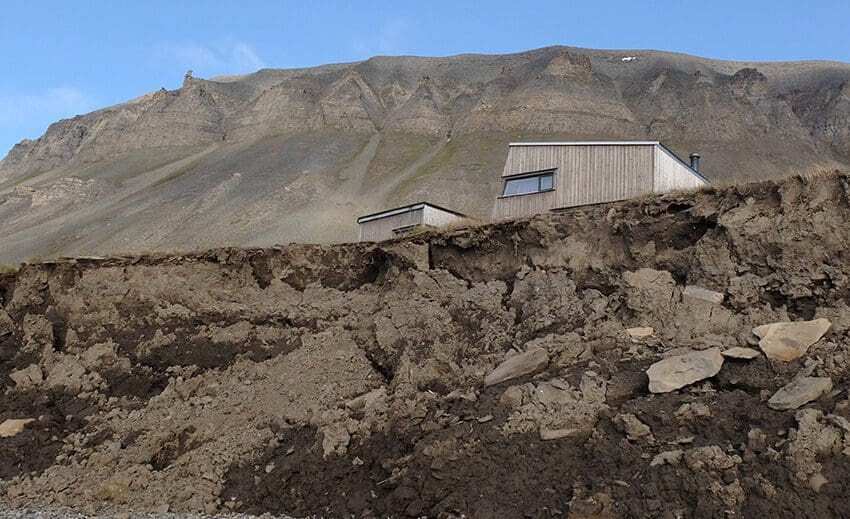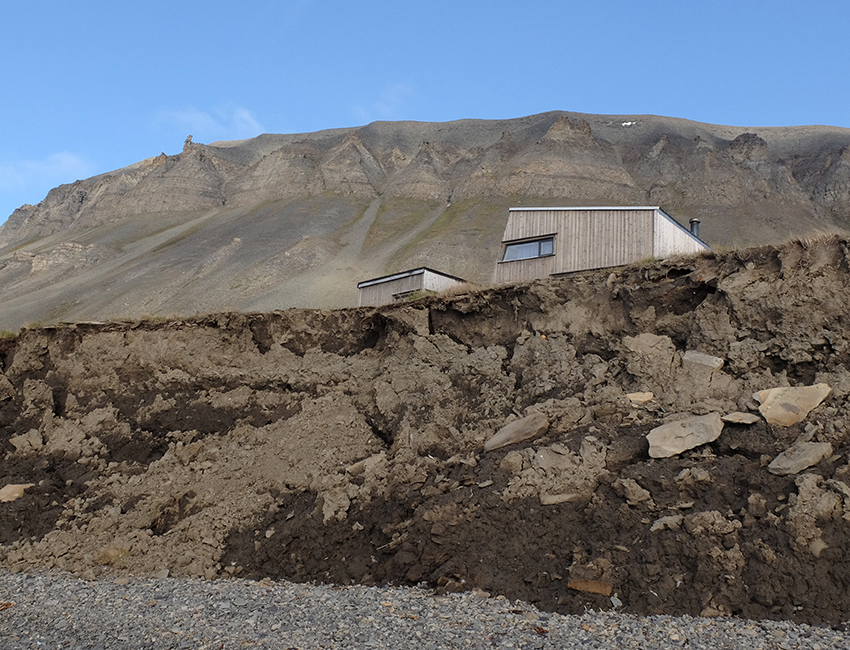AT-801 Arctic Infrastructures in a Changing Climate (10 ECTS)
ID:
AT-801
CREDITS:
10 ECTS
APPLICATION DEADLINE:
April 15, 2024
START DATE:
September 23, 2024
END DATE:
October 31, 2024
COURSE PERIOD:
Autumn semester (Block 6)

Cabin threatened by coastal erosion, Bjørndalen. Photo: Eva Therese Jenssen/UNIS
| Grade: | Letter grade (A through F) |
| Course Cost: | Fieldwork, ca. NOK 400 (2 days x NOK 200 per overnight stay) |
| Course Capacity Min/Max: | 10/25 students (AT-301/801 in total) |
| Language of instruction: | English |
| Examination support material: | Bilingual dictionary between English and mother tongue.Non-programmable calculator. |
Course requirements
Enrolment in a relevant PhD programme. Knowledge in mathematics and physics at master level.
Academic content:
The course is intended for students with interests and background in geotechnics, building materials, structures, energy systems, dynamics, and mechanics. With the observed climate changes with higher temperatures, more precipitation and probably higher storm activity, infrastructures have to be designed for projected climate changes. Settlements in the vicinity of steep slopes will be exposed to increasing risk for slope failures, slides in soil and rock, slush and snow avalanches. Through lectures and field trips the course will focus on recognizing sites and terrain exposed to avalanches and slides, and how to plan and protect infrastructures for sustainability and for minimizing damage risk.
Specific topics:
- Introduction in global warming phenomena, amplification effects in the Arctic
- Observation and modeling of temperature in the ground, and soil thermal properties
- Design of infrastructures in the Arctic and in a changing climate
- Probability and consequences of natural hazards
- General information about avalanches: types, release mechanisms, snow stability evaluation methods, avalanche protection, snow physics, a computer program for avalanche simulation. Field trip and experiments devoted to rockfalls and avalanches
- Field trip devoted to observations of foundation types and frost related damages
- Planning and design of buildings and structures in snowdrift areas
Learning outcomes
Upon completing the course, the students will:
Knowledge
- describe weather and climate-related geological processes and geotechnical aspects connected to planning, design and protection of infrastructures as buildings, roads, bridges and pipelines in the Arctic conditions
- evaluate uncertainties in climate models and predictions
- explain the impact of changing climate conditions on infrastructures in the Arctic
- interpret the influence of climate change on natural disasters as snow avalanches and soil sildes and rockfalls
- establish terrain models for critical slopes, chose parameters for, and apply numerical models for soil slide and snow avalanche
- examine the possibilities for alternative energy sources in remote Arctic areas and explain the principles of a borehole thermal energy storage (BTES)
- implement the basic elements of risk assessment towards engineering practice and structures in Arctic conditions.
Skills
- execute simple evaluations of natural hazards during areal planning and design of infrastructure
- estimate runoff distances for avalanches and rockfalls by applying simple analytical models and numerical simulation programs (e.g. RAMMS)
- design finite element models and run numerical computations for different thermodynamic processes related to stability of infrastructure in frozen ground
- describe the limitations of the available computer models for avalanches, slides, and rockfalls.
General competences
- design and perform field experiments involving logistical operations, data collection using scientific instruments, and data processing
- write engineering reports and present the results on related issues
- read and critically discuss scientific literature
- manage group tasks and workload within the group when conducting a collective exercise.
Learning activities
The course extends over ca 5 weeks including compulsory safety training, and is run in combination with AT-301.
Learning activities consist of lectures, seminars, two field excursions and fieldwork.
Through lectures students will be introduced to academic content of the course. Lectures are supplemented with exercises referring to “Anderson and Ladanyi, Frozen Ground Engineering” (2004). Fieldwork reports and a report from the numerical modeling of avalanches must be approved in order to sit the exam.
During field excursions the students will investigate different foundation presented in Longyearbyen and Pyramiden. The students will work in small groups to train teamwork skills. Based on observations from field excursions, the students shall produce a joint report describing observed foundation types and structural failures caused by lack of maintenance and possibly due to warmer climate, and present this to the class.
Fieldwork on rockfalls and avalanches will take place in proximity of Longyearbyen. Each student group shall prepare and present a joint report on evaluation of zones exposed to rockfall and/or avalanche hazards from the fieldwork.
Evaluation: 20% of the grade on a personal investigation and report on a course related topic within the expected competence field of the candidate; this will be agreed with the candidate. For instance it can be a thorough review on terrain mapping and implementation of this in an avalanche or rockfall modelling programme, or a review on the mathematical and physical basis of the common slide or avalanche simulation programmes. It can also be connected to planning, conducting and reporting of testing of soil mechanical properties or thermal properties in the laboratories, with a determination of properties needed for analyses and design.
Summary
- Total lecture and seminar hours: 50 hours.
- Fieldwork: 2 days.
- Field excursions: 3 days.
Compulsory learning activities
- Presentation of PhD project, seminars, assignments, fieldwork, field reports, and presentation of these.
- All compulsory learning activities must be approved in order to sit the exam.
Assessment
- All assessments must be passed in order to pass the course.
- Each assessment is graded, and subsequently combined into a single grade. Partial grades for each assessment will be available.
| Method | Duration | Percentage of final grade |
|---|---|---|
| Personal report; course related topic within the expected competence of the candidate | 20 % | |
| Written exam | 4 hours | 80 % |

